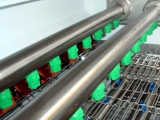Authored By:
Julie Fields
Technical Devices Company
Torrance, CA
Summary
This paper will discuss the environmental and financial cost of operating both batch cleaners and small inline aqueous cleaners. It is not the goal of this paper to endorse one type of cleaner over the other type, but rather to provide end users with a balanced look at the pros and cons of both batch cleaners and small inline cleaners.
Both types of cleaners have been widely available for use in production facilities since the 1980's. Choosing between a small inline and a batch cleaner can sometimes be an easy decision, but is most often a difficult dilemma without an obvious best choice. An objective look at the environmental and financial impact of both types of cleaners can help end users make a better decision for their specific applications.
This paper will compare the amounts of water, chemistry, and electricity used by both batch and inline cleaners. The environmental and financial impact of these measures will be discussed. Other factors such as floor space requirements, initial costs of the cleaners, and throughput capacity will also be examined.
Conclusions
The results of our tests showed that with regards to environmental factors neither the batch nor the small inline cleaner was a unanimous winner. The batch cleaner uses significantly less wash fluid (chemistry) per board than a small inline cleaner does. The margin is not as great with the rinse water loss, but once again the batch had lower losses than the small inline cleaner. However, in the power consumption category, the small inline cleaner was the winner.
Based on the financial cost only, the decision to select a batch cleaner or an inline cleaner comes down to what will cost more - chemistry for the wash section, water in your region or electricity in your region. From an environmental stand point, the choice of which of these 3 factors is more important may likely be mandated by state or local regulations.
Of course this decision has to be made with more than just the environmental factors in mind. If the PCBs aren't getting clean in the machine you choose, all of the resources are wasted. A careful examination of the cleaning capabilities both types of machines should be done not just for a company's current requirements, but as much as possible with future requirements in mind. A small inline cleaner certainly offers more flexibility and capabilities than a batch cleaner.
Those advantages also come with a higher initial capital investment, more floor space, and a greater use of chemistry. A batch cleaner is better at conserving chemistry in a closed loop wash system, but the throughput of boards is relatively small. The footprint diagram suggests that 3 batch cleaners would take up the same space as a small inline cleaner. Using 3 batch cleaners would triple the throughput, but would also triple the costs of the resources without adding any new cleaning capabilities.
There is no one size fits all solution for the problem of which type of cleaner to choose. Many factors must be considered in making the best choice possible for a company's particular cleaning requirements. Hopefully the consideration of these 3 factors will lead to a wiser choice when choosing a cleaner. Ideally it should not be only the cost but also the responsible use of resources - water, chemistry, and electricity that influence a decision to choose one type of cleaner over the other.
Initially Published in the IPC Proceedings
|

